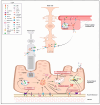Iron: More than Meets the Eye
- PMID: 41010490
- PMCID: PMC12472898
- DOI: 10.3390/nu17182964
Iron: More than Meets the Eye
Abstract
Iron is an essential micronutrient integral to ocular physiology, supporting biochemical processes such as mitochondrial respiration, DNA synthesis and phototransduction. Disruptions in systemic or local iron homeostasis, whether due to overload or deficiency, have been increasingly implicated in the pathogenesis of a broad range of anterior and posterior segment ocular disorders. Iron deficiency may compromise retinal bioenergetics, impair cellular repair, and increase susceptibility to oxidative stress, while iron overload facilitates the generation of reactive oxygen species, contributing to lipid peroxidation, mitochondrial dysfunction, and ferroptosis. Dysregulated iron metabolism has been associated with several ocular pathologies, including age-related macular degeneration, diabetic retinopathy, glaucoma, retinal detachment, cataracts, and anemic retinopathy. The eye possesses specialized iron regulatory mechanisms involving proteins such as transferrin, ferritin, ferroportin, and hepcidin that govern iron transport, storage, and export across ocular barriers. Aberrations in these pathways are now recognized as contributing factors in disease progression. This narrative review explores the complex dual role of iron overload and deficiency in ocular diseases. It highlights the molecular mechanisms underlying iron-mediated pathologies in both the posterior and anterior segments of the eye, along with the clinical manifestations of iron imbalance. Current therapeutic approaches are discussed, including oral and parenteral iron supplementation for deficiency and emerging chelation-based or antioxidant strategies to address iron overload, while highlighting their limitations. Key challenges remain in developing targeted ocular delivery systems that optimize bioavailability and minimize systemic toxicity. Hence, maintaining iron homeostasis is critical for visual function, and further research is needed to refine therapeutic interventions and clarify the mechanistic role of iron in ocular health and disease.
Keywords: aging; chelation; cornea; eye; iron; iron deficiency; iron overload; lens; retina.
Conflict of interest statement
The authors declare that they have no competing interests.
Figures
References
Publication types
MeSH terms
Substances
Grants and funding
LinkOut - more resources
Full Text Sources
Medical


